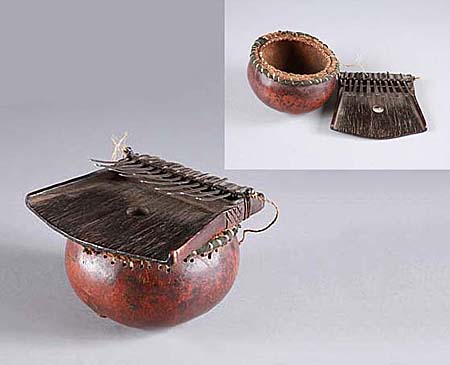
Owner: HWMC
Catalog#: 2AF-IDPL-23
Lamellophones
Tonga 'Kankobela' Kalimba - A
Zambia (Southern Province)
BaTonga
Wood, metal, calabash, rope, cloth
Mid 20th century
Length: 7 inches, Width: 6 inches; Diameter of gourd: 5 inches
Idiophone – Lamellophones – Plucked
The kankobela is a lamellophone of the Tonga (Batonga) people, who live in the Zambezi Valley on both sides of Lake Kariba in Zambia and Zimbabwe. It is a small instrument played by men to express their personal feelings in songs ranging from subjects of spiritual nature to casual ways of life. The kankobela is played alone without accompaniment but is dying out as there are few young players of this instrument.
This kankobela has a tray-shape sounding board with ridge carved sides at the top and a hole in the center. There are eleven (11) metal keys on this kankobela. Attached by a rope is a small calabash with a sewn cloth ridge. The kankobela is held over the calabash as an external resonator with the middle and ring fingers. This allows the performer to raise the kankobela up and down giving a wah-wah effect. The Kankobela does not always use a gourd resonator. Instead, tin cans are often used as they are less likely to crack or break.
According to several proposed theories, the thumb piano appeared twice in Africa. Once on the west coast about 3,000 years ago (with bamboo or wood slats) and a second time in the Zambezi Valley about 1300 years ago (with metal slats).
Resources: https://africamusica01.wordpress.com/2015/07/18/lamellophone-kankobela-kalimba-batonga-zambia/
Borel, François (1986). Collections d’instruments de musique. Les Sanza. Neuchâtel: Musée d’ethnographie.
